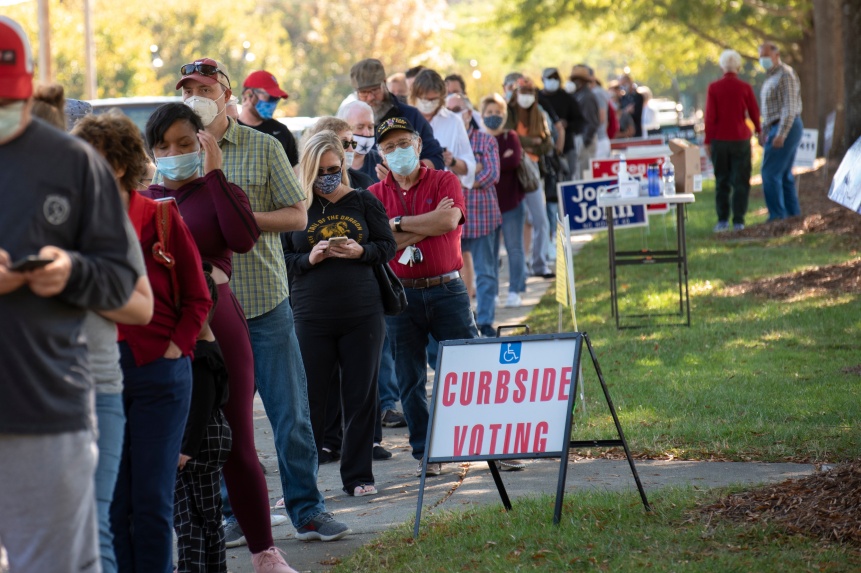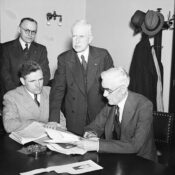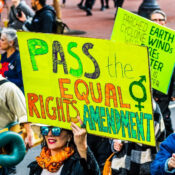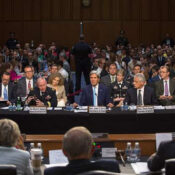The election of 2020 was unusual in many regards, not the least was how most Americans voted. According to Pew Research, 46 percent of voters cast their ballots through mail-in or absentee voting, a shift spurred by the pandemic. (In the 2016 and 2018 elections, only 23 percent of voters used mail-in/absentee ballots.) Another 27 percent voted early. Only 27 percent voted in person on election day.
The shift in voting methods stirred controversy, and in response, many states have recently introduced stricter voting measures. So, who, exactly, is in charge of all these voting rules?
Judging from our history, the power to control how, where, and when people voted — and who got to vote at all — has swung back and forth between the states and national government, along with considerable influence from the Supreme Court.
As contentious as voting rights are today, the trouble is nothing new. Voters’ rights have been a controversial subject for as long as the United States has been a nation. At the time the Constitution was being written, each state had its own rules governing who could vote. Some states even allowed women and African Americans to vote. Rather than overriding the laws for the various jurisdictions with a single standard, the framers of the Constitution deliberately avoided mentioning the “right to vote.”
The Federal government made its first major intervention in states’ electoral processes in 1869, when the 15th Amendment was passed. It prohibited the practice of denying (male) citizens the right to vote based on “race, color, or previous condition of servitude.” It was intended to ensure Black Americans would get to vote in states with a history of racism.
But when Reconstruction was dismantled in 1876, southern states introduced legal means — like poll taxes and literacy tests — to prevent Black Americans from voting.
There the matter stood until 1964, when three activists who were promoting minority voting rights in Mississippi were murdered. The national outrage led to the Voting Rights Act of 1965, which outlawed such obstacles as literacy tests. More significantly, it appointed federal examiners who could ensure eligible voters weren’t prevented from casting ballots.
One section of the law — Section 5 — went a step further. It required certain states and counties to obtain preclearance from federal authorities before instituting new voting procedures.
The effectiveness of the Act is reflected in the fact that the number of Black voters rose by a quarter million that year. And by 1966, nine of 13 southern states had more than half their Black voters registered.
Section 5 would have expired in five years, but it was extended in 1970, 1975, and 1986. It was again renewed in 2006, passing in the House 390 to 33 and in the Senate unanimously. Signing the renewal of the Act, President George W. Bush called it “an example of our continued commitment to a united America.”
In 1993, the federal government once again stepped into the voting process by passing the National Voter Registration Act. It was intended to reduce the difficulties in registering to vote, a reaction to the low turnout of the 1988 election, when only about 50 percent of voters cast a ballot.
The Act requires states to provide on-the-spot voter registration at select state government agencies. Since this is usually the department of motor vehicles, the law soon earned the title “Motor Voter” Act. Twenty years after the enactment, the Act was enabling 16 million Americans to register or re-register every year.
But there were still differences among the states, and some states were passing laws to more closely monitor and restrict who voted. In 2004, Arizona legislators, citing suspicions of voter fraud, passed a state law requiring registrants to submit proof of citizenship when registering, a practice not required by the Motor Voter act. In the two years that followed, Arizona denied voter registration to over 31,000 applicants who couldn’t provide the extra documentation the state law required. Voter registration fell sharply. Just in Maricopa County, which includes Phoenix, it dropped by 44 percent.
Voting rights activists challenged the law, ultimately taking their objections to the Supreme Court. The justices struck down the Arizona law, saying the state could not demand more information than was required by the Motor Voter Act. One of the lawyers who had been part of the appeal said the decision made it clear that states can’t block voter registration by “superimposing burdensome paperwork requirements on top of federal law.”
That same year, the Supreme Court made an even more momentous decision about voting laws. In Shelby County v. Holder, the justices struck down the section of the Voting Rights Act that required the nine areas named in the Act to obtain pre-approval before changing state voting laws.
Writing the majority opinion, Chief Justice John Roberts explained that America had made great strides toward racial justice. Federal oversight was no longer necessary when, for example, more Black voters than white were registered in Mississippi.
Since then, the states affected previously under Section 5 have passed new voter ID laws, some requiring registrants to prove not just their identity but also their citizenship.
Unfortunately, more than 20 million Americans do not have government issued photo ID. Around 25 percent of Black voters lack a government-issued photo ID (only 8 percent of white voters do). Lower-income voters may find the cost of obtaining ID expensive — between $75 and $175 — and inconvenient in rural areas. Strict photo ID laws can mean thousands of votes lost in state elections, according to a Washington Post study. And a Caltech/MIT study found that voter ID is more frequently challenged among minority voters than white voters
In 2014, another Washington Post report found that, of one billion ballots cast between 2000 and 2014, photo IDs would have prevented just 31 substantial cases of voter impersonation.
That brings us to today, where the COVID-19 pandemic dramatically changed the way people did everything, including vote. During the 2020 election, 30 states changed their voting laws to make voting easier, including expanding absentee and early voting, pre-mailing ballots to voters, and installing drop boxes. More than 159 million people voted, the largest turnout in U.S. history.
Some state legislators, impelled by debunked rumors of massive voter fraud in the election, have sponsored bills in to make the laws concerning registering and voting more stringent. Legislators in 47 states have introduced over 360 bills to impose restrictions on voting, according to the nonpartisan Brennan Center for Justice. Most of the bills aim to reduce absentee voting. Others seek stricter voter ID requirements. Five of the bills have been signed into law, and another 55 bills are moving through 24 state legislatures. Twenty-nine have passed at least one chamber.
Meanwhile, other legislators have proposed laws to make registering to vote and voting more accessible. At present, 112 bills have been introduced in 31 state legislatures to expand voting rights. Many of these laws would expand absentee balloting or the opportunities for registering to vote. Nine of the bills have been passed so far.
Politicians at the federal level haven’t been idle, either.
Democrats in the House of Representatives have introduced H.R. 1. Nicknamed the “For the People Act,” it’s an ambitious piece of legislation that would introduce changes to the electoral processes, campaign finances, foreign influence, ethics, and other areas.
It has passed the House but faces serious challenges in the Senate from both Democratic and Republican senators.
As you can imagine, the House bill to expand voting and the state laws to restrict voting will, sooner or later, collide. And when that happens, unfortunately, the Constitution won’t provide clear-cut directions in this matter.
Article I, Section 4, Clause 1 authorizes state legislatures to prescribe for “the times, places, and manner of holding elections for Senators and Representatives.” It’s a good, clear-cut statement of responsibility, but it’s undermined by the subsequent phrase, “but the Congress may at any time by Law make or alter such Regulations.”
It is unclear just how this arrangement is supposed to work out, but there’s no doubt that plenty of people will have opinions about it; nine of those people will likely be Justices of the Supreme Court.
Featured image: Shutterstock
Become a Saturday Evening Post member and enjoy unlimited access. Subscribe now



